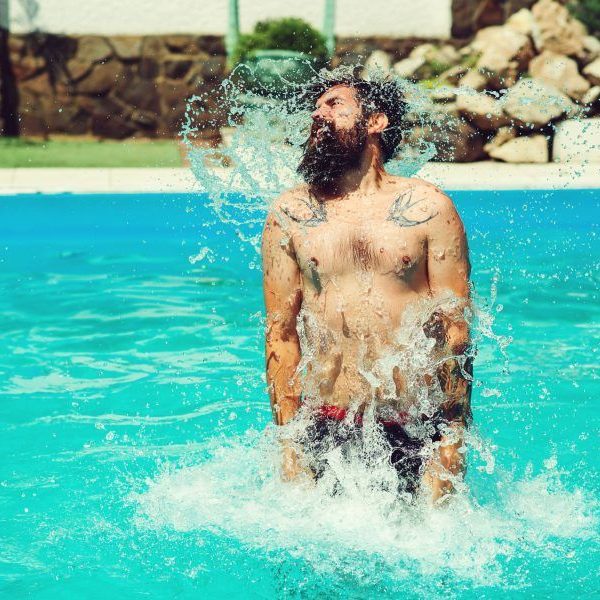Introduction: Understanding Tattoo Healing
Getting a tattoo is an exciting experience for many people. However, with this new body art comes the responsibility of proper aftercare. One crucial aspect of care is knowing when it’s safe to resume swimming. Swimming too soon after getting a tattoo can lead to complications like infections or faded designs. Understanding the healing process is essential for maintaining the quality and appearance of your new tattoo. This article will explore why swimming should be avoided immediately after getting a tattoo and provide guidelines for safe practices.
The Healing Process of a Tattoo
Initial Healing Phase
The healing process of a tattoo typically occurs in two phases: the initial healing phase and the long-term healing phase. The first phase usually lasts about 2 to 3 weeks. During this time, the skin forms a protective layer over the tattoo. This layer helps prevent germs and bacteria from entering the open wound.
In this phase, the tattoo may appear red, swollen, and might even scab over. It’s crucial to take extra care of your tattoo during this period. Activities like swimming should be avoided, as exposing the tattoo to water can introduce bacteria and hinder the healing process.
Long-Term Healing Phase
After the initial healing phase, the tattoo enters a long-term healing phase which can last anywhere from 3 to 6 months. While the outer layer of skin may look healed, the deeper layers are still undergoing recovery. Even though you might feel tempted to swim again, caution is key.
Just because the surface looks good doesn’t mean it’s fully healed underneath. If the tattoo still feels sensitive or itchy, swimming should be avoided. This extra precaution allows your body to heal properly and maintain the integrity of the tattoo. Understanding these phases can help you gauge when it’s safe to return to the pool or ocean.

Risks of Swimming Too Soon
Infection and Complications
Swimming in pools, lakes, or ocean water poses significant risks if done too soon after getting a tattoo. Pools and lakes are usually filled with bacteria and chemicals that can enter the fresh ink and cause infections. An infected tattoo can lead to serious complications, requiring medical treatment.
Signs of infection include increased redness, swelling, and pus. If you notice any of these symptoms, consult a medical professional immediately. Taking the time to let your tattoo heal properly protects not only your artwork but also your health. Avoiding swimming in the early stages reduces the risk of complications and ensures a safe healing environment.
Fading and Distortion
Another consequence of swimming too soon is the potential for fading or distortion of the tattoo design. Chlorine, saltwater, and microorganisms can weaken the ink and affect the way the tattoo retains its vibrancy. As the skin absorbs these elements, the colors may bleed or become less defined.
This fading not only compromises the aesthetics of the tattoo but may also lead to the need for touch-ups or re-inking in the future. Being patient and avoiding swimming until the tattoo is fully healed will preserve the quality of your ink. Protecting your investment now will save you from additional costs and frustration later.

Guidelines for Swimming After Getting a Tattoo
Recommended Waiting Period
Most tattoo artists recommend waiting at least 2 to 4 weeks before resuming swimming. However, this timeframe can vary depending on individual healing rates and the specific tattoo’s size and location. Consulting your tattoo artist is crucial, as they can provide personalized advice based on your tattoo and skin type.
If the tattoo appears fully healed after two weeks, you may consider testing your reaction to swimming. Start with short exposure and monitor how your skin responds. If everything looks good, you can gradually increase your swimming time. Listening to your body is important during this process.
Signs Your Tattoo Is Ready
Before diving back into the water, it’s essential to observe specific signs that indicate your tattoo is ready for swimming. First, check for any remaining scabs. If there are no scabs and the surface of the tattoo looks smooth, it may be a good sign. The skin shouldn’t feel tender or sore to the touch.
Also, look for an even color and texture. If the tattoo appears vibrant and colorful without swelling or irritation, you’re likely in the clear. Still, if there are any doubts, waiting a little longer is the safer option. When in doubt, consult your tattoo artist for their professional opinion.
Alternative Activities During Healing
Enjoying a Relaxing Bath
While you may need to avoid swimming, there are still enjoyable alternatives during the healing process. Taking a relaxing bath can be a soothing experience without directly soaking the tattoo. Fill the tub with warm water and add some soothing bath salts, making sure to keep the tattooed area out of the water.
Allow the rest of your body to enjoy the calming sensations while you protect your new art. This allows you to unwind without risking the integrity of your tattoo. Just ensure that the water isn’t too hot, as excessive heat can irritate healing skin.
Other Leisure Activities
In addition to baths, consider alternative leisure activities that don’t involve water. Going for strolls, enjoying a movie at home, or even reading a book are great ways to pass the time while waiting for your tattoo to heal. This period can be an excellent opportunity to explore new hobbies or catch up on pending tasks.
Focusing on other interests can make the waiting game less tedious. Engaging in light activities helps distract you from the urge to swim while ensuring you take the necessary precautions to care for your tattoo. Transform this waiting time into a positive experience.

Caring for Your Tattoo
Follow Aftercare Instructions
Proper aftercare is fundamental to ensuring your tattoo heals correctly. After getting the tattoo, follow the aftercare instructions provided by your artist meticulously. This typically includes washing the tattoo with mild soap and lukewarm water and applying a thin layer of ointment or moisturizer.
Avoid picking at scabs or peeling skin, as this can lead to scarring and affects your tattoo’s appearance. Keeping the area clean and moisturized promotes faster healing while enhancing the final outcome. Your patience in following these guidelines will pay off when the time comes to admire your beautiful new art.
Monitor Your Healing Progress
Regularly monitoring the healing progress of your tattoo is essential. Check for any unusual changes, such as increased redness, itching, or discharge. If you notice any signs of infection or complications, consult a healthcare professional right away.
Keeping an eye on how the tattoo is healing helps you determine the right time to resume swimming. Document your healing journey with photos to track your tattoo’s progress. This practice also offers the opportunity to reminisce about the healing process once your tattoo is fully healed.
Enjoying Swimming Again
Reintroducing Swimming Slowly
When your tattoo has healed, it’s time to dive back into swimming. However, ease back into your routine. Start with shorter sessions in the pool or ocean and observe how your skin reacts. Monitor the tattoo for any irritation or discomfort during and after swimming.
If everything looks and feels good, you can gradually increase your swimming time. Remember that your skin may still be sensitive, so gentle movements in the water are advisable. Reintroducing swimming slowly ensures your tattoo remains in great condition.
Protecting Your Tattoo in the Water
Even after your tattoo is fully healed, it’s a good idea to protect it from prolonged exposure to harsh substances like chlorine or saltwater. Consider applying a layer of waterproof sunscreen before swimming. This helps shield your tattoo from fading due to sun exposure and harsh elements.
Additionally, rinsing off after swimming can wash away chlorine or salt that might harm the tattoo over time. Taking these extra steps will help maintain the vibrancy and quality of your tattoo for years to come. By adopting these precautions, you can enjoy swimming while preserving your beautiful body art.
Conclusion: The Importance of Patience
In conclusion, knowing how long to wait before swimming after getting a tattoo is essential for proper healing. Understanding the healing process, associated risks, and guidelines can help you take the best care of your new body art. Avoiding swimming for at least 2 to 4 weeks ensures that your tattoo heals correctly, reducing the chances of complications.
Listening to your body and keeping an eye on your tattoo’s progress is key. Use this time to explore other enjoyable activities while your tattoo heals. Once the healing process is complete, feel free to enjoy swimming again while taking preventive measures to protect your tattoo.
Ultimately, patience and aftercare will result in a vibrant, lasting tattoo that you can proudly display. Remember, taking the time to care for your new ink will ensure it remains as stunning as the day you got it!
